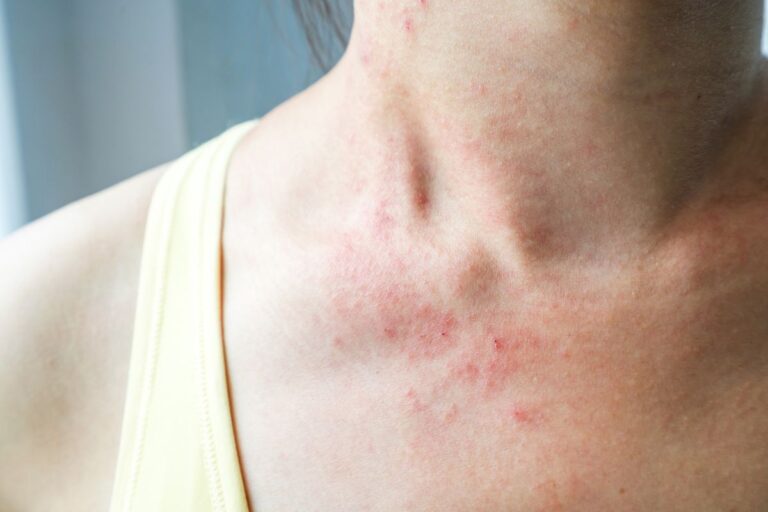A rash on the chest can a symptom of a chronic skin condition, specific infections or reaction from medication. Learn more about causes, treatment or remedy for skin rashes.
What is the rash on the chest? – Causes
A rash can manifest in various ways according to its underlying cause and predisposing or related factors.
Eczema (Dermatitis)
One of the common reasons for a rash on the chest is contact dermatitis which may refer to skin inflammation or an adverse reaction to something that touches the skin.
Irritant contact dermatitis
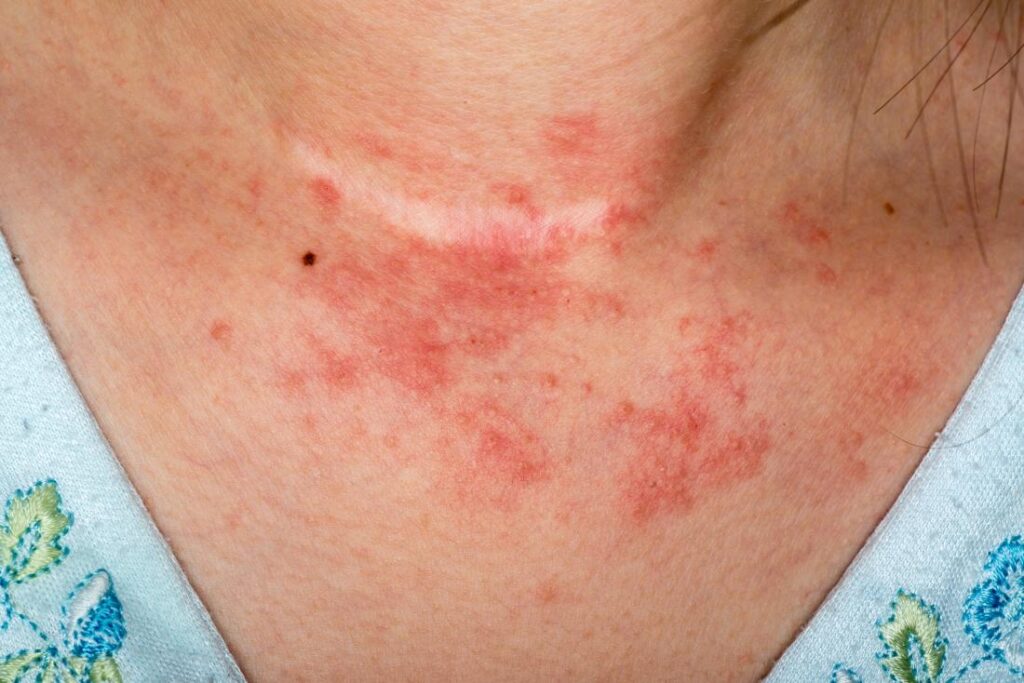
This type of contact dermatitis is caused by irritants touching the skin after prolonged contact. A typical example of contact dermatitis leading to a chest rash is a necklace rubbing on the chest area.
Symptoms of rash on chest caused by irritant contact dermatitis include itching, reddening of the skin, (little or tiny) small bumps or blisters.
Other substances that cause irritation include
- Detergents and harsh soap
- Bubble bath
Lack of appropriate measures or treatment can lead to thickening, flaking, and dryness of skin or change in color.
Allergic contact dermatitis
Being allergic to specific substances the immune system responds by producing body chemicals to counter-effect a potential reaction due to the detected presence of that substance.
Common allergens include poison ivy, oak or poison sumac. Allergic reactions may also be triggered by certain foods, products or. Other trigger causes include:
- Necklace made from Nickel/coating
- Fragrances
- Deodorants
- Medications (drug rash). See below
- Certain chemicals used in lotions
Allergy symptoms include itching, (red) bumps or swelling
Some forms of allergic contact dermatitis are dangerous or life-threatening. For example, a food allergy can produce adverse symptoms such as breathing problems, shrinking of blood vessels, vomiting or serious swelling which can lead to death.
The most effective means of dealing with allergic reactions is avoiding allergens and trigger substances once your culprits are identified.
Nummular eczema

Nummular eczema is characterized by irritated skin with coin-sized patches. Areas affected include legs, arms or chest.
Symptoms of nummular eczema usually start with irritation in small areas of skin. These areas develop into red crusted or scaly patches. According to Drugs.com, this type is related to atopic dermatitis more than allergic contact dermatitis.
Drug rash or allergy
Another skin rash that can present itself as chest rash a drug reaction. The appearance of the rash may vary with the underlying infection or problem that requires that specific medication.
Examples of medicines that have shown to trigger rashes include diuretics, anticonvulsants (phenytoin), drugs used in chemotherapy and mental problems.
One of the common symptoms of a chest rash due to medication is itching. Other possible signs or symptoms include
- Formation of red bumps
- Patches on skin
- Hives
- Blisters
Drug reactions can affect particular body parts or have a widespread effect in response to a specific medication. Some people are reported to have developed the sensitivity to sunlight. Less fortunately, drug reactions may occur sometimes in specific conditions.
Treatment
The best way to avoid chest rash caused by a drug allergy is to stop using it. Pathologists prefer blood tests prior to treatment.
Prescription medication
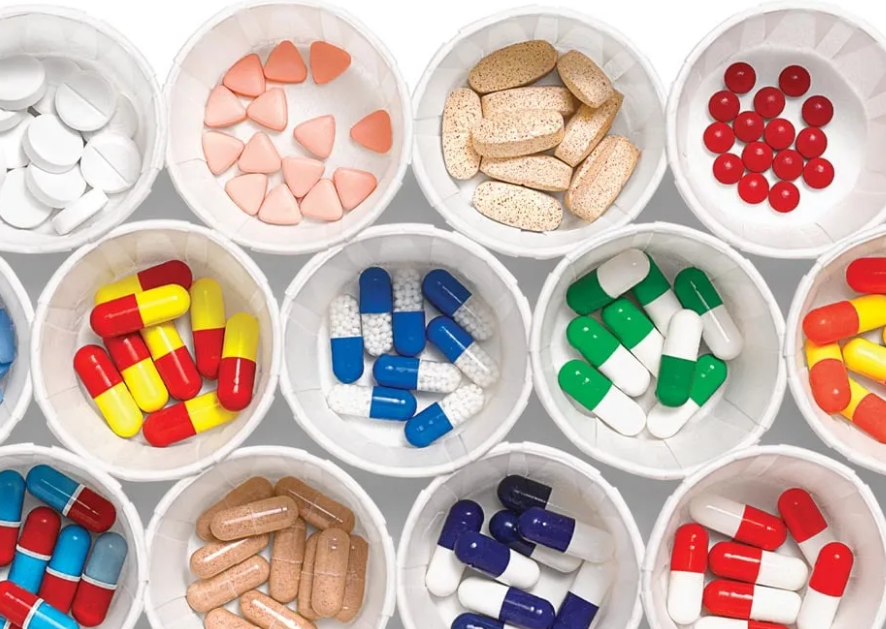
Your doctor should prescribe medications to deal with itching, inflammation or stop the release of histamine (chemical antibodies). Self-treatments for potential drug allergy especially in children is discouraged.
CAUTION: Patients should NOT stop prescription medication in case they develop an allergy. (Unless as advised by a physician)
If you suspect that you have an itchy skin rash that almost resembles hives, inform the medics. And remember to carry a list the medicines with you.
Heat or sweat rash
Heat or sweat rash is another possible cause of a rash on your chest. Heat rash is mainly caused by blocked sweat glands. However, hot and humid weather or clothing can cause (sweat) heat rash. If you sweat more you are likely to get it.
This rash is characterized by the formation of small or tiny blister-like bumps that occasionally cause itching. Sometimes it may cause a fever.
Good thing is that heat rash is harmless and often goes away on its own.
Pityrosporum Folliculitis

Moving on, pityrosporum folliculitis is an acne-like rash that occurs after pityrosporum yeast invasion of hair follicles. The yeast normally inhabits the superficial skin surface but causes no harm when it is regulated or controlled with the body.
Although pityrosporum folliculitis is not an infection in itself, it is characterized by an itching small-sized, pink and round-shaped pimple-like eruption on skin surface affected. The areas affected most by this kind of rash tend to show even spreading which may be limited to the chest and upper back.
The occurrence of this rash is manifested in older people owing to the general notion that skin resistance lowers with age. Other helpful factors to explain why it occurs include:
- Individuals with oilier skin or getting used to applying body with oils
- A hot and humid environment that encourages individuals to sweat more
- Diabetic conditions including the triggers like stress
- Medications such as antibiotics
Patients sometimes think they have hives or mites after especially scratching their skin. Moreover, there is a likely association of pityrosporum folliculitis occurring in people with skin conditions such as seborrheic dermatitis around the neck, on scalp or the face. Also, acne patients can experience worsening symptoms if they co-occur.
Treatment
Dermatologists first prioritize in getting control of pityrosporum overgrowth because of its high probability in recurring.
Second, topical oral treatment is given as prescriptions to adults for a certain period. Above all, a more effective form of medication may be given by your dermatologist.
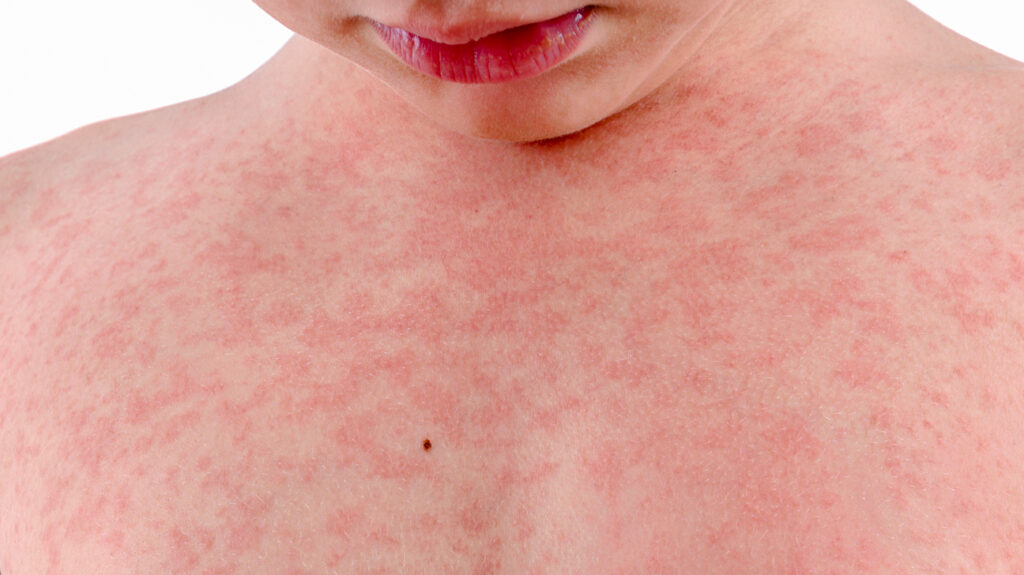
Exanthems is a collective term for rashes caused by viral infections. While some rashes affect certain areas of the body, most viral rashes have a widespread tendency in symptoms. The following are common viral infections that cause rashes on the skin including the chest.
A. Chickenpox
Chickenpox is caused by a varicella-zoster virus. It affects children very often.
Symptoms
Fever, loss of appetite and headache are the first common signs of chickenpox before the rash (red or pink bumps) starts.
This rash marked by itchy red or pink, is seen all over the body usually on the second day after these first symptoms. Before healing, the rash will go through phases involving blistering and scabbing.
Treatment remedies for the rash
Your doctor will carry out tests on the blisters and prescribe medication for itching, headache and fever. Parents are also advised to feed the affected individuals on fluids.
Notably, the virus is contagious until the bumps have cleared. Furthermore, the virus may go into a “resting” period even after recovery.
B. Shingles
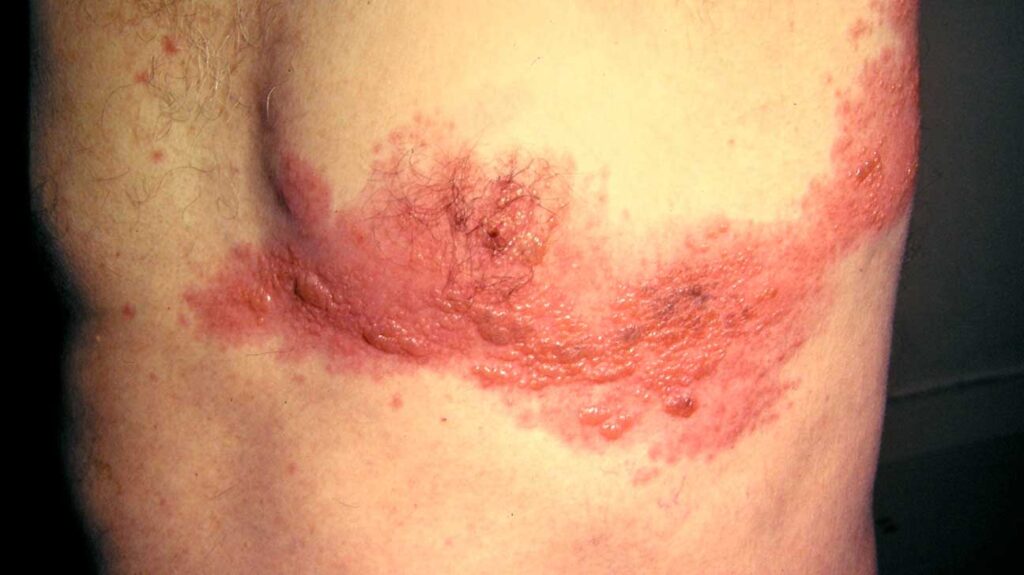
Shingles is a painful skin rash that occurs after someone has recovered from chickenpox. This is more likely because of the “reactivation” of the varicella-zoster virus which remains dormant in nerves located in certain parts of the body.
The chest is one of the common areas where shingles can occur. It is more common in older people than those young but anyone can get shingles if they previously had chickenpox.
Common symptoms of rash caused by shingles include
- Burning sensation (usually among the first signs)
- Painful red bumps
- Clustered (or linear) itchy blisters on the chest after at least 1 day
- Itching
- Fever
- Aches and chills all over the body
Most people with shingles on the chest usually complain about persistent pain, which is a common complication of this rash especially when it occurs on the face.
Care and treatment for people with shingles

Much caution should be taken when taking care of people who have never suffered from chickenpox.
If your child has the above symptoms or suspect he may be suffering from shingles, you should clean him with caution since the virus can be spread.
Most are prescription medications. The following treatment options can take care of the symptoms. They include:
- Applying an anti-itch medication
- Pain relievers such as Ibuprofen, Acetaminophen
- Washing the area with less harsh soap daily
- Antiviral medicines such as Acyclovir, Famciclovir
One of the effective ways of preventing shingles by taking your child to be vaccinated against chickenpox
C. Molluscum contagiosum
Another viral infection causing a chest (skin) rash is Molluscum contagiosum. The rash is characteristic of small growths or wart-like bumps (called mollusca) that are usually pink, white, or skin-colored.
Infection typically occurs at the point where the virus enters the body, usually through cuts in skin. The virus can spread to other body parts (including the trunk, neck and face) causing a mild rash.
The rash is common in kids. Unlike the rest of the viral rashes, Molluscum contagiosum does not cause produce serious symptoms – i.e. the rash is mild.
Fortunately, the rash is nothing to cause much worry since it resolves on its own. Therefore, treatment may not be a priority, though consider taking your child for tests.

- Measles
- Rubella
- Roseola
- Erythema infectiosum
- Viral hepatitis
Stings or bites
Some biting insects or stings can also cause a rash on the chest. The rashes due to either may vary according to the way your body may respond to substances injected in the skin. Let us take the following real scenarios.
A sting or stings in the chest can potentially result to an adverse reaction (allergy). The reaction can lead to a rash where painful bumps may form or swell in the skin. Examples of insects causing this reaction include bees and wasps.
Secondly, animal bites can cause chest rash. For instance, chronic irritation or inflammation in skin and transmission of an infection characteristic of eruptions.
- Tick bites cause Lyme disease which produces a skin rash.
- Itch mites can also cause a skin rash
Depending on what causes the bites or sting, itching is a notable symptom. Swelling, blistering and scabbing could occur.
Diagnosis of chest rash
Why is it important? There are different causes of a rash on the chest which may be difficult to identify. For the specific treatment of skin conditions or infection symptoms, a diagnosis is necessary.
The diagnosis of most eczema types requires a biopsy test. Sometimes your dermatologist or doctor needs to examine the condition of affected areas on your skin. Your doctor may as well ask for your medical history if the symptoms are due to a chronic condition.
In some cases, your doctor can request for a blood test.
Remedies for a chest rash
Do you need remedies if you have a rash on the chest? Remedies for rashes help alleviate skin condition such as eczema. Medicines are mostly used but natural products sometimes may be applicable.
If you have a fever try using over the counter painkillers such as ibuprofen for a short period only. See your doctor if you have a high fever accompanied by headache. For minor itching and skin irritation try calamine lotion or oatmeal.
How to manage chest rashes
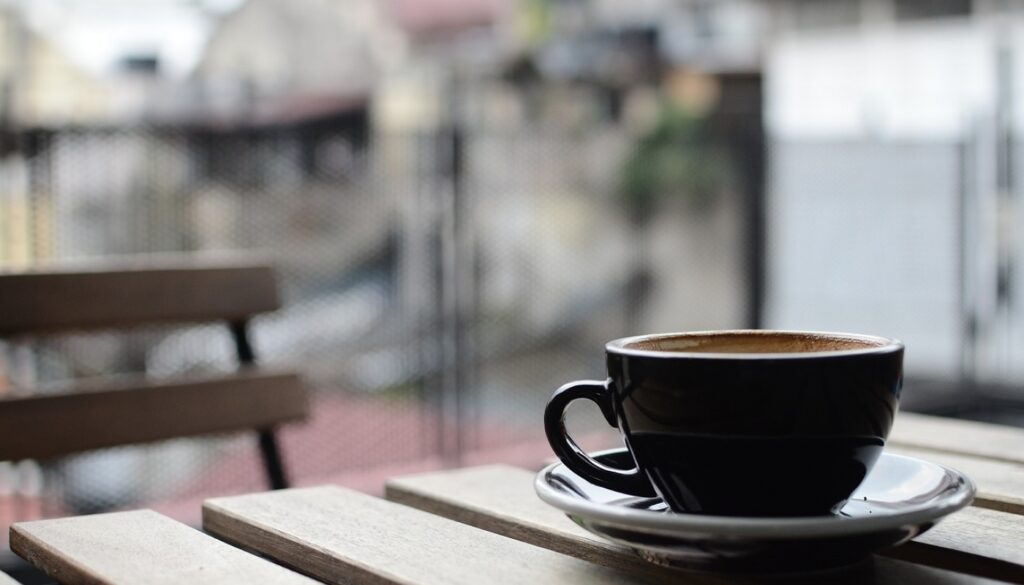
Chest rashes due to contact dermatitis can be prevented in the future if you observe and practice self-care to the latter. Here are top tips for you.
- Avoid hot beverages if you often suffer from heat rash or sweat rash
- Do not scratch. It can cause infection or worsen itchy skin rashes
- Avoid clothing that can increase sweating especially during pregnancy
- Change your clothing often. Doing so will assist you in identifying whether it is a potential reaction
- Observe daily body cleaning (e.g. take shower after and every workout) to control sweating
- Apply a fragrant-free moisturizer to address dryness, scabbing or cracking of the skin
Conclusion
Anyone can get a rash on the chest. From our discussion, there is a good number of causes with various widespread symptoms or symptoms affecting your chest more than other areas. Self-care measures for skin conditions like eczema can help avoid symptoms from developing or becoming worse. Talk to your dermatologist if your chest rash or condition recurs.

